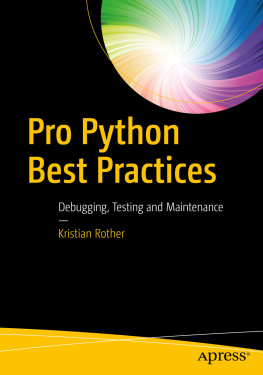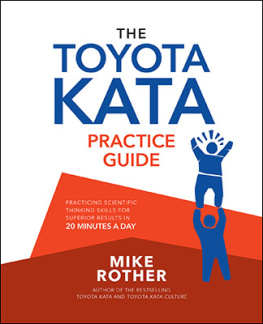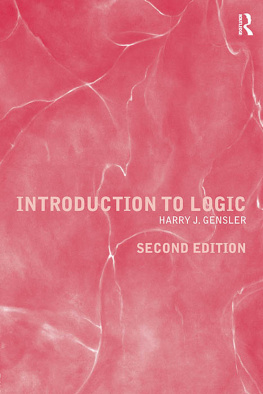TOYOTA KATA
TOYOTA KATA
MANAGING PEOPLE FOR
IMPROVEMENT, ADAPTIVENESS,
AND SUPERIOR RESULTS
MIKE ROTHER


Copyright 2010 by Rother & Company, LLC. All rights reserved. All rights reserved. Except as permitted under the United States Copyright Act of 1976, no part of this publication may be reproduced or distributed in any form or by any means, or stored in a database or retrieval system, without the prior written permission of the publisher.
ISBN: 978-0-07-163985-9
MHID: 0-07-163985-3
The material in this eBook also appears in the print version of this title: ISBN: 978-0-07-163523-3, MHID: 0-07-163523-8
E-book conversion by codeMantra
Version 2.0
All trademarks are trademarks of their respective owners. Rather than put a trademark symbol after every occurrence of a trademarked name, we use names in an editorial fashion only, and to the benefit of the trademark owner, with no intention of infringement of the trademark. Where such designations appear in this book, they have been printed with initial caps.
McGraw-Hill Education eBooks are available at special quantity discounts to use as premiums and sales promotions or for use in corporate training programs. To contact a representative please visit the Contact Us page at www.mhprofessional.com.
TERMS OF USE
This is a copyrighted work and McGraw-Hill Education and its licensors reserve all rights in and to the work. Use of this work is subject to these terms. Except as permitted under the Copyright Act of 1976 and the right to store and retrieve one copy of the work, you may not decompile, disassemble, reverse engineer, reproduce, modify, create derivative works based upon, transmit, distribute, disseminate, sell, publish or sublicense the work or any part of it without McGraw-Hill Educations prior consent. You may use the work for your own noncommercial and personal use; any other use of the work is strictly prohibited. Your right to use the work may be terminated if you fail to comply with these terms.
THE WORK IS PROVIDED AS IS. McGRAW-HILL EDUCATION AND ITS LICENSORS MAKE NO GUARANTEES OR WARRANTIES AS TO THE ACCURACY, ADEQUACY OR COMPLETENESS OF OR RESULTS TO BE OBTAINED FROM USING THE WORK, INCLUDING ANY INFORMATION THAT CAN BE ACCESSED THROUGH THE WORK VIA HYPERLINK OR OTHERWISE, AND EXPRESSLY DISCLAIM ANY WARRANTY, EXPRESS OR IMPLIED, INCLUDING BUT NOT LIMITED TO IMPLIED WARRANTIES OF MERCHANTABILITY OR FITNESS FOR A PARTICULAR PURPOSE. McGraw-Hill Education and its licensors do not warrant or guarantee that the functions contained in the work will meet your requirements or that its operation will be uninterrupted or error free. Neither McGraw-Hill Education nor its licensors shall be liable to you or anyone else for any inaccuracy, error or omission, regardless of cause, in the work or for any damages resulting therefrom. McGraw-Hill Education has no responsibility for the content of any information accessed through the work. Under no circumstances shall McGraw-Hill Education and/or its licensors be liable for any indirect, incidental, special, punitive, consequential or similar damages that result from the use of or inability to use the work, even if any of them has been advised of the possibility of such damages. This limitation of liability shall apply to any claim or cause whatsoever whether such claim or cause arises in contract, tort or otherwise.
Contents
Foreword
Mike Rothers Toyota Kata is a rare and exciting eventa book that casts entirely new light on a much heralded set of management practices, giving those practices new significance and power. Countless people in the past 20 or more years have studied and written about Toyotas wildly successful management thinking and practice. But paradoxically, despite the vast amount of knowledge presented in these works, no organization outside Toyotas family of companies has ever come close to matching Toyotas stellar performance. There is a widespread feeling that something Toyota does is still not understood and put into practice by non-Toyota companies.
Toyota Kata will change all that. In this book, Mike Rother penetrates Toyotas management methods to a depth never before reached. In doing so, he offers a set of new ideas and practices that enables any organization, in any business, to do what it takes to match Toyotas performance.
This is not the first book in which Mike Rother presents path-breaking insights into Toyota. He advanced the business worlds understanding of Toyotas methods light-years in his 1998 book Learning to See, coauthored with John Shook. A brief look at the message of
Learning to See describes and explains a mapping tool Toyota uses to see how work moves from the start of production to delivering finished product to the ultimate customer. Known inside Toyota as material and information flow mapping, Rother, Shook, and publisher Jim Womack renamed Toyotas tool value-stream mapping and explained it for the first time in their book. Thanks to the enormous success of Learning to See, value-stream mapping became one of the most widely used tools to teach and practice Toyotas vaunted production system.
With the value-stream mapping tool, Rother and Shook show how to use many of Toyotas well-known techniques systematically to change a conventional batch-oriented mass-production factory flowreplete with countless interruptions and massive delaysinto a flow resembling what one finds in a typical Toyota factory. Familiar names for some of these techniques are takt time, andon, kanban, heijunka, and jidoka. For most students of Toyota, Learning to See was the first extensive and clear explanation into how to use Toyotas techniques to improve across an entire facility.
That book, however, does not explore why and how these techniques evolved, and continue to evolve, at Toyota. Although Learning to See provides a monumental step forward in understanding how Toyota achieved the remarkable results it has enjoyed for over 50 years, it does not reveal why others, after implementing Toyota-style techniques, still seem unable to emulate Toyotas performance. How does Toyota develop its solutions? What specific process do they use? Now, in Toyota Kata: Managing People for Improvement, Adaptiveness, and Superior Results, Mike Rother shows us this next vital layer of Toyota practice.
The central message of Toyota Kata is to describe and explain Toyotas process for managing people. Rother sets forth with great clarity and detail Toyotas unique improvement and leadership routines, or kata, by which Toyota achieves sustained competitive advantage. The transformative insight in Toyota Kata is that Toyotas improvement kata and coaching kata both transcend the results-oriented level of thinking inherent in the management methods still used in most companies in the Western world.
The findings in Toyota Kata confirm my own interpretation of what I observed so often in Toyota operations since my first study mission to Toyotas giant facility (TMMK) in Georgetown, Kentucky, in 1992. What distinguishes Toyotas practices from those observed in American and other Western companies is their focus on what I call managing by means, or MBM, rather than managing by results, or MBR. As far back as 1992, I learned from President Fujio Cho and members of his management team at Georgetown that Toyota steadfastly believes that organizational routines for improvement and adaptation, not quantitative/financial targets, define the pathway to competitive advantage and long-term organizational survival.
Next page







